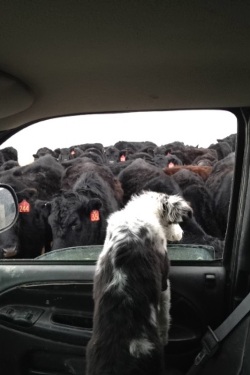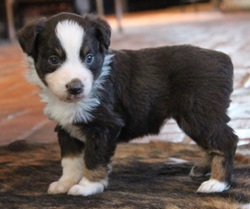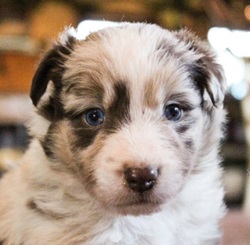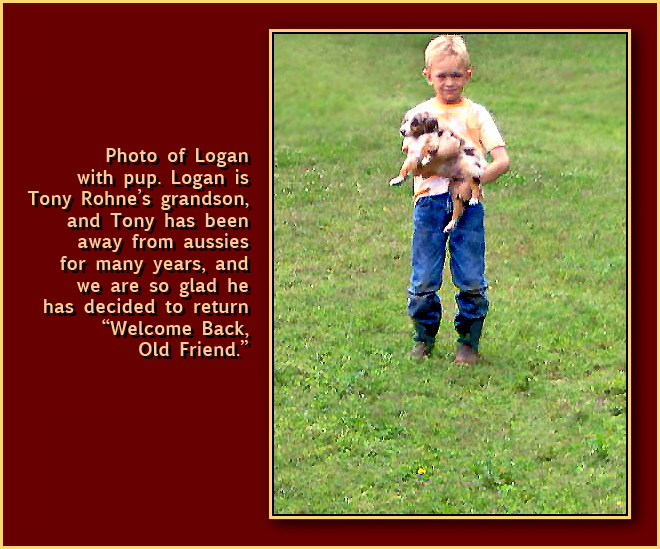| |
|

Raising
a Working Bred Australian Shepherd Cowdog
for Ranch and Farm Work
(the Hart II way)
Hart II’s Australian Shepherds breeds stockdogs, working dogs for farmers, ranchers, and family companions. For over thirty years our ASCA Hall of Fame sires and ASCA Hall of Fame dams have provided the genes, and we have provided the dedication in preserving the Australian Shepherd breed
as stockdog. We are happy to share in a condensed form here our programs for raising healthy Aussie puppies and hard-working Aussie cowdogs.
We do not breed our female Aussies more than once a year, and we wait until they are at least 2 years old before
breeding. Ask your Vet about a brucellosis test for sire and dam before breeding your Australian Shepherd stockdogs.
Mom does not work livestock once she is bred and for 2 months after whelping (running or extreme exercise while nursing pups may cause mastitis). We do not allow mom to run with other stockdogs while she has young pups.
We use a homemade whelping box out of
wood 36" long x 36" wide x 18" deep with a wooden rail
around the inside to prevent pups from getting mashed between mom and
box. This box has a 22"x 8" hinged door for mom to get in
and out of box. Mom comes into our mudroom 2 weeks before whelping and
is introduced to her whelping area. We put an X-pen around the box and
old sheets in the box until 2 days before whelping. Then we put in a
low pile carpet cut to fit the box. Wash and air the new carpet out,
as it has chemicals harmful to pups. We change the carpet every day
and keep strangers out of this area.
Mark your calendar at birth. Mom and pups
do not live outside until the pups are 3 weeks old. Puppies cannot regulate
their own body temperatures until they are 10 days old. Floor temperature
in the room should be 82 F. at birth. Call your vet if you become concerned
during whelping. We have a puppy heating pad for warmth if necessary,
or we use the a/c if too warm. Get a book on whelping puppies or read
up about what to expect online. Puppies go to the vet to have their
tails, front, and rear dew claws removed at three days old. Mom goes
too, as she needs 1 cc of oxytocin, and an exam by vet. Pick up puppies
every day after 3 days old. Do not allow children to handle pups unattended.
Our Aussie stockdog puppies are introduced
to solid food at 3 weeks old. Pups are still with their moms at this
age, of course. This food is water  soaked to mush, maybe only l tablespoon
of food on the first day per pup. After a couple of days we add Nutri-Cal
vitamin supplement, and cottage cheese to mush. We stop soaked food
at 5 weeks old, but still add Nutri-Cal. Feed once a day, then twice
a day, then 3 times a day. Overfeeding may cause diarrhea, so we feed
more often with less per feeding, which also helps prevent low blood
sugar problems. When our Aussie stockdog puppies are 4 months old we
slowly reduce feeding to once a day. We feed our dogs an all-natural
dog food. We use no chemicals in or on the mom while she’s nursing
pups. We use diatomaceous earth for flea prevention. Clean the puppy
area every day. soaked to mush, maybe only l tablespoon
of food on the first day per pup. After a couple of days we add Nutri-Cal
vitamin supplement, and cottage cheese to mush. We stop soaked food
at 5 weeks old, but still add Nutri-Cal. Feed once a day, then twice
a day, then 3 times a day. Overfeeding may cause diarrhea, so we feed
more often with less per feeding, which also helps prevent low blood
sugar problems. When our Aussie stockdog puppies are 4 months old we
slowly reduce feeding to once a day. We feed our dogs an all-natural
dog food. We use no chemicals in or on the mom while she’s nursing
pups. We use diatomaceous earth for flea prevention. Clean the puppy
area every day.
Wormers: Puppies are wormed at 3 weeks
old, 5 weeks, 7 weeks and 9 weeks with Panacur,
one cc per 10 lbs. of body weight. First worming of pups is about one-fifth
(1/5th) of a cc. Worm the mom with same wormer on the same schedule
while nursing pups. Mom weans pups "her way" at about 7 weeks
of age. We have the area designed where mom can get in with pups, and
away from pups as desired. We worm all of our dogs once a year with
Panacur.
Vaccines: Puppies, at 6 weeks old are
given 1 cc Max 5-CvK Puppy Shot, at 9 weeks old Max 5-CvK/4L, then at
12 weeks old another Max 5-CvK/4L and their rabies vaccine. They are
started on Interceptor
Tabs for heartworm prevention, and Advantix topical to prevent fleas and ticks at 4 months old.
We do not send our Australian Shepherd
pups to their new homes until they are at least 9 weeks old. We give
all our dogs a Max 5-CvK/4L vaccine yearly and a rabies vaccine every
other year. Also, we give all dogs an Intra-Trac Nasal vaccine in the
fall to prevent kennel cough. All dogs are given an Interceptor Tablet
once a month year-round. Please do not use ivermectin wormer on your
Australian Shepherd as it may be fatal to some Aussies. We use Advantix
topical for flea, tick prevention once a month year round. We do not
stop at road-side parks to exercise our pups, as this is where the pup
may be exposed to doggie diseases; instead, we pick a side road with
little traffic, and pull off a safe distance.
If you have several dogs, feed each dog
separately. Also, do not leave your Aussie puppy loose or unattended
around adult dogs. Pups may be irritating to adult dogs and that may
cause the adult dog to injure the pup. We feed an all-natural dog food.
We were skeptical when we switched to natural foods about 15 years ago.
Our Aussie working dogs are beyond a doubt healthier and happier, less
waste, and we feed less. Also, fewer vet bills save $$$! We want to
keep our Aussies in top working condition, not under or overweight.
Overweight puppies have stress on their
joints and underweight puppies may not develop properly. We are currently
feeding Solid Gold Dog Food. Petco sells this dog food.
Adult Aussies can have rawhides. Milk
Bones for pups, as they may choke on rawhides. Table scraps? Yes, for
adult dogs. No more than one tablespoon per day. No fowl bones, pork
bones, spicy food, grapes, chocolate, or onions. We teach pups to sit
with a piece of hotdog, or cheese. Beware of mouse poison, fertilizers,
weed killers, and anti-freeze, as these are deadly to dogs.
Know the Australian Shepherd breed:
Aussies are sound and movement sensitive, which keeps them alive among
flying hooves. Beware and keep dogs in a safe secure spot during thunderstorms,
firecrackers and gunfire.
Recommended books to learn more about
caring for your Hart II’s Australian Shepherd stockdog pup:
"Dog
Owners Home Veterinary Handbook"
by Delbert G. Carlson, DVM and James Giffin, MD
"Natural
Health for Dogs and Cats”
by Dr. Richard H. Pitcairn, DVM and Susan Hubble Pitcairn
"How
to Raise a Puppy You Can Live With"
by Clarice Rutherford and David Neil
We
hope this has been helpful. Any questions, call us.
| |
|







